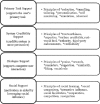Persuasive design features within a consumer-focused eHealth intervention integrated with the electronic health record: A mixed methods study of effectiveness and acceptability
- PMID: 31220127
- PMCID: PMC6586306
- DOI: 10.1371/journal.pone.0218447
Persuasive design features within a consumer-focused eHealth intervention integrated with the electronic health record: A mixed methods study of effectiveness and acceptability
Abstract
Introduction: eHealth strategies targeting health-related behaviour often incorporate persuasive software design. To further engage patients with their overall health management, consumer-facing web portals may be integrated with data from one or more care providers. This study aimed to explore effectiveness for healthier behaviour of persuasive design characteristics within a web application integrated with the primary health care electronic record; also patient and general practitioner (GP) preferences for future integrated records.
Methods: Mixed methods study within the Consumer Navigation of Electronic Cardiovascular Tools randomised controlled trial. Participants were patients with moderate-high risk of cardiovascular disease, and their GPs. Survey and web analytic data were analysed with descriptive statistics. Interview and focus group transcripts were recorded, transcribed, coded and analysed for themes.
Results: Surveys (n = 397) received from patients indicated improved medication adherence (31.8%); improved mental health and well-being (40%); higher physical activity (47%); and healthier eating (61%). Users of the interactive features reported benefiting from personalised cardiovascular disease risk score (73%); goal tracking (69%); risk factor self-monitoring (52%) and receipt of motivational health tips (54%). Focus group and interview participants (n = 55) described customisations that would increase portal appeal and relevance, including more provider interaction. Of the GP survey respondents (n = 38), 74% reported increased patient attendance and engagement with their care. For future integrated portals, 94% of GPs were in favour and key themes among interviewees (n = 17) related to design optimisation, impact on workflow and data security.
Conclusion: Intervention features reflecting the persuasive design categories of Primary Task support, Dialogue support and System Credibility support facilitated healthier lifestyle behaviour. Patients valued customisable functions and greater patient-provider interactivity. GPs identified system challenges but saw advantages for patients and the health care relationship. Future studies could further elucidate the persuasive design principles that are at play and which may promote adoption of EHR-integrated consumer portals.
Conflict of interest statement
The authors have declared that no competing interests exist.
Figures


Similar articles
-
An Internet-Based Intervention for Cardiovascular Disease Management Integrated With Primary Care Electronic Health Records: Mixed Methods Evaluation of Implementation Fidelity and User Engagement.J Med Internet Res. 2021 Apr 26;23(4):e25333. doi: 10.2196/25333. J Med Internet Res. 2021. PMID: 33900204 Free PMC article. Clinical Trial.
-
Implementation of a consumer-focused eHealth intervention for people with moderate-to-high cardiovascular disease risk: protocol for a mixed-methods process evaluation.BMJ Open. 2017 Jan 11;7(1):e014353. doi: 10.1136/bmjopen-2016-014353. BMJ Open. 2017. PMID: 28077414 Free PMC article.
-
Development of an integrated e-health tool for people with, or at high risk of, cardiovascular disease: The Consumer Navigation of Electronic Cardiovascular Tools (CONNECT) web application.Int J Med Inform. 2016 Dec;96:24-37. doi: 10.1016/j.ijmedinf.2016.01.009. Epub 2016 Jan 24. Int J Med Inform. 2016. PMID: 26847070
-
The Use and Effects of Electronic Health Tools for Patient Self-Monitoring and Reporting of Outcomes Following Medication Use: Systematic Review.J Med Internet Res. 2018 Dec 18;20(12):e294. doi: 10.2196/jmir.9284. J Med Internet Res. 2018. PMID: 30563822 Free PMC article.
-
Key Components in eHealth Interventions Combining Self-Tracking and Persuasive eCoaching to Promote a Healthier Lifestyle: A Scoping Review.J Med Internet Res. 2017 Aug 1;19(8):e277. doi: 10.2196/jmir.7288. J Med Internet Res. 2017. PMID: 28765103 Free PMC article.
Cited by
-
World Heart Federation Roadmap for Digital Health in Cardiology.Glob Heart. 2022 Aug 26;17(1):61. doi: 10.5334/gh.1141. eCollection 2022. Glob Heart. 2022. PMID: 36051317 Free PMC article.
-
The Effects of a Digital Mental Health Intervention in Adults With Cardiovascular Disease Risk Factors: Analysis of Real-World User Data.JMIR Cardio. 2021 Nov 19;5(2):e32351. doi: 10.2196/32351. JMIR Cardio. 2021. PMID: 34806986 Free PMC article.
-
Effectiveness of an eHealth self-management tool for older adults with multimorbidity (KeepWell): protocol for a hybrid effectiveness-implementation randomised controlled trial.BMJ Open. 2021 Feb 17;11(2):e048350. doi: 10.1136/bmjopen-2020-048350. BMJ Open. 2021. PMID: 33597147 Free PMC article.
-
Factors Reducing the Use of a Persuasive mHealth App and How to Mitigate Them: Thematic Analysis.JMIR Hum Factors. 2023 Jun 26;10:e40579. doi: 10.2196/40579. JMIR Hum Factors. 2023. PMID: 37358883 Free PMC article.
-
An Internet-Based Intervention for Cardiovascular Disease Management Integrated With Primary Care Electronic Health Records: Mixed Methods Evaluation of Implementation Fidelity and User Engagement.J Med Internet Res. 2021 Apr 26;23(4):e25333. doi: 10.2196/25333. J Med Internet Res. 2021. PMID: 33900204 Free PMC article. Clinical Trial.
References
Publication types
MeSH terms
LinkOut - more resources
Full Text Sources
Medical

